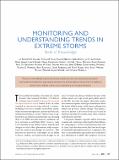| dc.contributor.author | Kunkel, Kenneth E. | |
| dc.contributor.author | Karl, Thomas R. | |
| dc.contributor.author | Brooks, Harold | |
| dc.contributor.author | Kossin, James P. | |
| dc.contributor.author | Lawrimore, Jay H. | |
| dc.contributor.author | Arndt, Derek | |
| dc.contributor.author | Bosart, Lance | |
| dc.contributor.author | Changnon, David | |
| dc.contributor.author | Cutter, Susan L. | |
| dc.contributor.author | Doesken, Nolan | |
| dc.contributor.author | Groisman, Pavel Ya. | |
| dc.contributor.author | Katz, Richard W. | |
| dc.contributor.author | Knutson, Thomas R. | |
| dc.contributor.author | O'Brien, James | |
| dc.contributor.author | Paciorek, Christopher J. | |
| dc.contributor.author | Peterson, Thomas C. | |
| dc.contributor.author | Redmond, Kelly | |
| dc.contributor.author | Robinson, David | |
| dc.contributor.author | Trapp, Jeff | |
| dc.contributor.author | Vose, Russell | |
| dc.contributor.author | Weaver, Scott | |
| dc.contributor.author | Wehner, Michael | |
| dc.contributor.author | Wolter, Klaus | |
| dc.contributor.author | Wuebbles, Donald | |
| dc.contributor.author | Emanuel, Kerry Andrew | |
| dc.date.accessioned | 2013-10-03T15:16:34Z | |
| dc.date.available | 2013-10-03T15:16:34Z | |
| dc.date.issued | 2013-04 | |
| dc.date.submitted | 2012-05 | |
| dc.identifier.issn | 0003-0007 | |
| dc.identifier.issn | 1520-0477 | |
| dc.identifier.uri | http://hdl.handle.net/1721.1/81287 | |
| dc.description.abstract | The state of knowledge regarding trends and an understanding of their causes is presented for a specific subset of extreme weather and climate types. For severe convective storms (tornadoes, hailstorms, and severe thunderstorms), differences in time and space of practices of collecting reports of events make using the reporting database to detect trends extremely difficult. Overall, changes in the frequency of environments favorable for severe thunderstorms have not been statistically significant. For extreme precipitation, there is strong evidence for a nationally averaged upward trend in the frequency and intensity of events. The causes of the observed trends have not been determined with certainty, although there is evidence that increasing atmospheric water vapor may be one factor. For hurricanes and typhoons, robust detection of trends in Atlantic and western North Pacific tropical cyclone (TC) activity is significantly constrained by data heterogeneity and deficient quantification of internal variability. Attribution of past TC changes is further challenged by a lack of consensus on the physical link- ages between climate forcing and TC activity. As a result, attribution of trends to anthropogenic forcing remains controversial. For severe snowstorms and ice storms, the number of severe regional snowstorms that occurred since 1960 was more than twice that of the preceding 60 years. There are no significant multidecadal trends in the areal percentage of the contiguous United States impacted by extreme seasonal snowfall amounts since 1900. There is no distinguishable trend in the frequency of ice storms for the United States as a whole since 1950. | en_US |
| dc.description.sponsorship | United States. National Oceanic and Atmospheric Administration. Climate Program Office (Award NA07OAR4310063) | en_US |
| dc.description.sponsorship | Cooperative Institute for Climate and Satellites, North Carolina (Cooperative Agreement NA09NES4400006) | en_US |
| dc.language.iso | en_US | |
| dc.publisher | American Meteorological Society | en_US |
| dc.relation.isversionof | http://dx.doi.org/10.1175/BAMS-D-11-00262.1 | en_US |
| dc.rights | Article is made available in accordance with the publisher's policy and may be subject to US copyright law. Please refer to the publisher's site for terms of use. | en_US |
| dc.source | American Meteorological Society | en_US |
| dc.title | Monitoring and Understanding Trends in Extreme Storms: State of Knowledge | en_US |
| dc.type | Article | en_US |
| dc.identifier.citation | Kunkel, Kenneth E., Thomas R. Karl, Harold Brooks, James Kossin, Jay H. Lawrimore, Derek Arndt, Lance Bosart, et al. “Monitoring and Understanding Trends in Extreme Storms: State of Knowledge.” Bulletin of the American Meteorological Society 94, no. 4 (April 2013): 499-514. © 2013 American Meteorological Society | en_US |
| dc.contributor.department | Massachusetts Institute of Technology. Department of Earth, Atmospheric, and Planetary Sciences | en_US |
| dc.contributor.mitauthor | Emanuel, Kerry Andrew | en_US |
| dc.relation.journal | Bulletin of the American Meteorological Society | en_US |
| dc.eprint.version | Final published version | en_US |
| dc.type.uri | http://purl.org/eprint/type/JournalArticle | en_US |
| eprint.status | http://purl.org/eprint/status/PeerReviewed | en_US |
| dspace.orderedauthors | Kunkel, Kenneth E.; Karl, Thomas R.; Brooks, Harold; Kossin, James; Lawrimore, Jay H.; Arndt, Derek; Bosart, Lance; Changnon, David; Cutter, Susan L.; Doesken, Nolan; Emanuel, Kerry; Groisman, Pavel Ya.; Katz, Richard W.; Knutson, Thomas; O'Brien, James; Paciorek, Christopher J.; Peterson, Thomas C.; Redmond, Kelly; Robinson, David; Trapp, Jeff; Vose, Russell; Weaver, Scott; Wehner, Michael; Wolter, Klaus; Wuebbles, Donald | en_US |
| dc.identifier.orcid | https://orcid.org/0000-0002-2066-2082 | |
| mit.license | PUBLISHER_POLICY | en_US |
| mit.metadata.status | Complete | |
